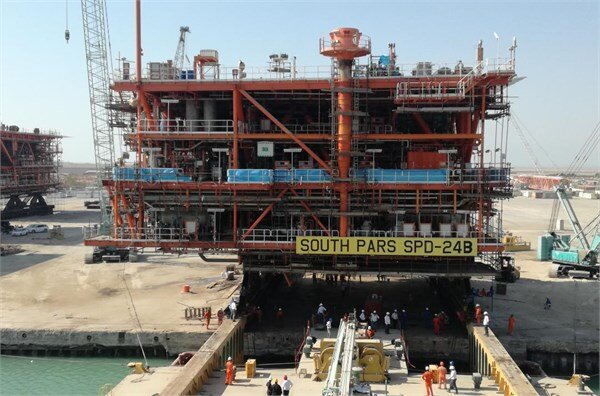Last platform of South Pars phases 22-24 loaded

TEHRAN- Platform SPD-24B, which is the last platform of the phases 22, 23, 24 of developing South Pars gas field (in the Persian Gulf), was loaded at Sadra yard in the southwestern province of Bushehr on Thursday.
According to a report released by Pars Oil and Gas Company (POGC), which is in charge of the gas field development, the 2,500-ton structure loaded on FLB124 barge through pull-push method.
Phases 22-24 are expected to produce 56 million cubic meters of sour gas, 75,000 barrels of gas condensate, and 400 tons of sulfur per day, in addition to 50 million cubic meters of methane, 2,900 tons of LPG and 2,750 tons of ethane.
South Pars gas field, which Iran shares with Qatar in the Persian Gulf, covers an area of 9,700 square kilometers, 3,700 square kilometers of which, called South Pars, are in Iran’s territorial waters. The remaining 6,000 square kilometers, called North Dome, are situated in Qatar’s territorial waters.
The field is estimated to contain a significant amount of natural gas, accounting for about eight percent of the world’s reserves, and approximately 18 billion barrels of condensate.
On September 15, POGC managing director announced that all the remaining platforms of the field will be installed by the end of the current Iranian calendar year (March 19, 2020).
Speaking to the state TV, Mohammad Meshkinfam said “By the end of this year, the five remaining South Pars platforms at Sadra industrial yard will be installed [on their designated offshore spots] and recovery from all South Pars gas blocks (except for phase 11) will be realized.”
The development of South Pars Field started 22 years ago and 29 different phases were defined for the project along with a separate oil block.
"After the full development of the South Pars joint field, we should consider maintaining production based on the prospect of supplying 75 percent of the country's gas consumption for 25 years,” Meshkinfam said.
According to the official, although there has been no noticeable decrease in the field’s recovery factor so far, but it is anticipated that it will decrease within the next three to four years.
"Focusing on the blocks [like Belal gas field] around the South Pars field is one of the long-term solutions for maintaining the field’s recovery factor,” he said.
MA/MA
